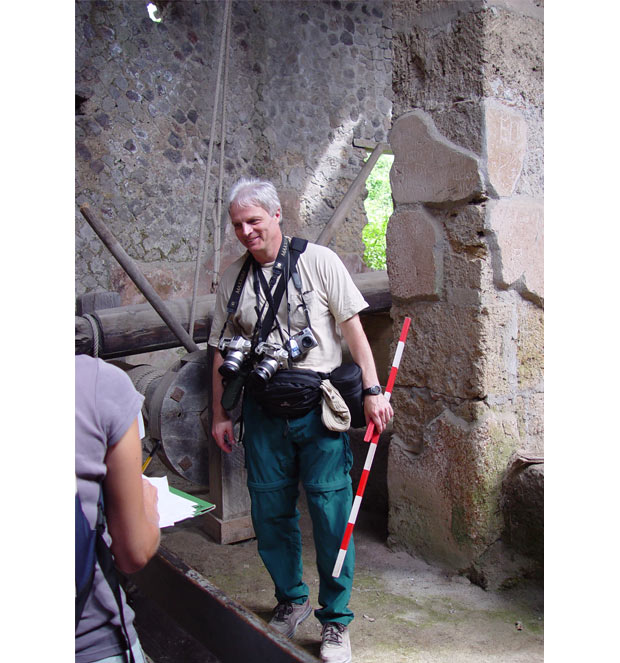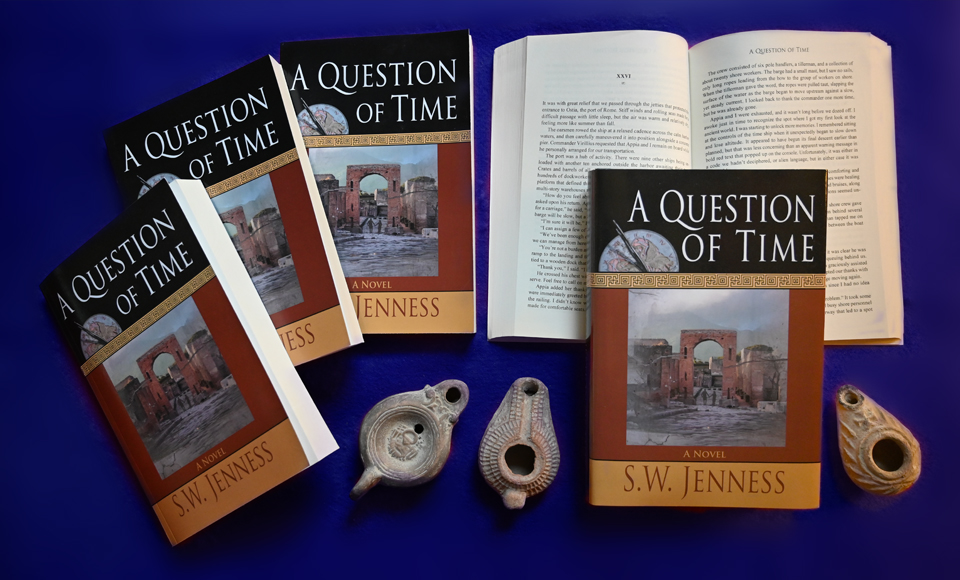Available in hardcover, paperback and Kindle.
A Question of Time
A Novel by S.W. Jenness
A Question of Time might be best described as historical science fiction set in the age of the Flavian emperors of ancient Rome. I used my many years of study, both academic and in the field, to craft a fictional story built on a nonfictional foundation with regard to history, culture and science. Below I briefly delve into these three aspects that shaped much of the story.
I've also added two photo sections, Pompeii Views and Rome Views, offering a sense of the era from which the story unfolds.
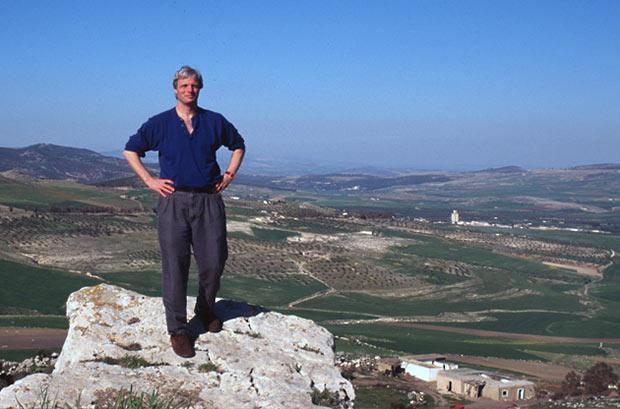
Studying Greek and Roman sites around the Mediterranean.
Historical background: The Flavian dynasty. The first Flavian emperor, Vespasian, came to power on December 21, 69CE, at the end of a turbulent year that saw the rise and fall of three emperors, Galba, Otho and Vitellius. Vespasian's reign lasted ten years, to 79CE, another year of turbulence, but not for political reasons. Vespasian died in the summer of 79CE. His son Titus took over as emperor in a smooth transition of power, but that's where the tranquility ended. Emperor Titus was soon faced with a series of three great disasters beginning with the eruption of Vesuvius, followed by a devastating fire in Rome, and lastly, a plague.
History has generally been kind to Vespasian and Titus, although, folks in Jerusalem might not concur. However, from a Roman contemporary perspective, writers of the Flavian and post Flavian eras considered both to be good emperors. Considering the potential bias in ancient historical writing, they may not have been as good as stated, but there is evidence to support competent leadership and generosity, especially from Titus, as his actions during the disastrous years of 79 and 80CE have shown.
Domitian was the younger son of Vespasian, becoming emperor in September 81CE following the death of Titus. Domitian was twelve years younger than Titus. Their childhoods were very different and the relationship between them may well have been strained and even contentious. History has not been as kind to Domitian despite a peaceful reign of fifteen years that saw the strengthening of the economy and an expansion of the Empire. He was assassinated in 96CE, perhaps due to his micromanaging and a strict authoritarian rule that weakened senatorial power. His cremation was supposedly handled without a ceremony.
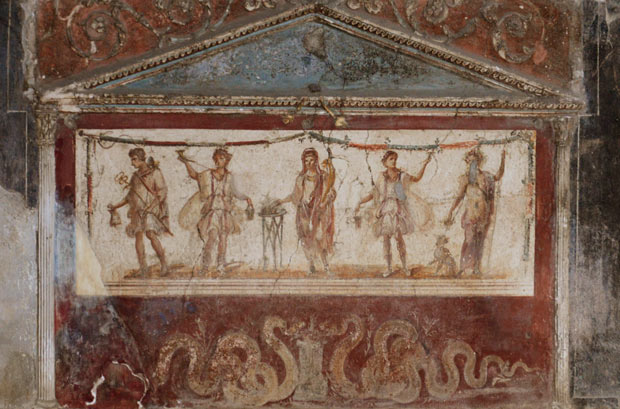
Culture. It's impossible to know precisely what any past culture was like, but with the ancient Roman culture there are known pieces from which to create best guesses. Slavery is one such piece as it permeated all aspects of Roman life.
My book Roman focuses on a wealthy patrician and his household slaves. This type of slavery sometimes paid wages, offering a way for a slave to buy his or her freedom at some point in the future. However, freedom for a freed slave was not the same as being freeborn citizen. There usually remained a link to their master, possibly as a patron or steward. Some freed males could vote, but no freed slaves could run for political office or assume senatorial status. However, the children of freed slaves were considered freeborn.
The ancient understanding of freedom is another piece for consideration. Our concept of freedom for all and a classless society were completely unknown in ancient times. The real Spartacus would not have revolted for the cause of freedom as we know it despite his depiction in the 1960 movie Spartacus. In fact, in many instances former slaves were quick to purchase slaves of their own. The key to success was property, which included human as well as land and livestock.
The household slaves in my novel are well off in a relative sense, which is not out of touch with reality. Favorable conditions were dependent on the good humor of their benefactor. That didn't necessarily insulate household from inhuman abuses, but as a whole they were potentially better off than the slaves who worked the fields, or in the mines where there was no hope of bettering their condition. It's also quite possible that many household slaves considered themselves better off than the landless poor, who were freeborn citizens but without property.
Honor was another piece of the cultural puzzle, at least among the male nobility. The appearance of honor was everything to a Roman citizen of rank. Rules regarding social behavior needed to be strictly followed, and yet, when reading between the lines, the perception of honor was more likely the reality.
The role of women and what it was like to be a woman in this era is very difficult to ascertain. A tiny handful had wealth, a modicum of political influence and did well, but they were not the rule. There is little documentation for the vast majority of women in most ancient societies. However, through legal documents and bits and pieces of evidence in other writing from academic to graffiti, it was possible to create plausible female characters for that place and time.
Festivals, the calendar and religion all played roles in daily Roman life, and I gave it my best effort to bring those cultural elements into the story as they related to the main characters.
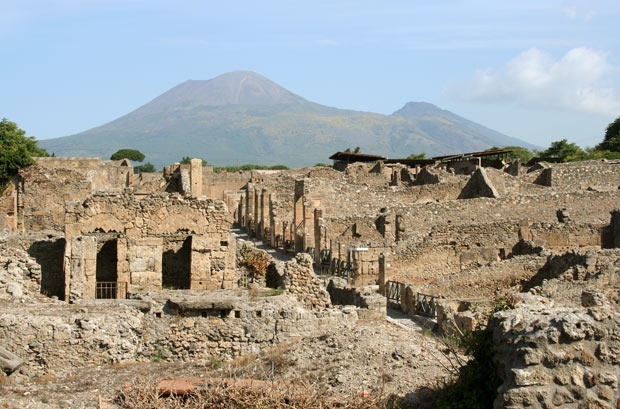
The ruins of Pompeii with Mount Vesuvius in the distance.
Science: Vulcanology and the force of nature. I have a fascination for volcanoes and have spent countless hours researching the events preceding and during the famous 79CE eruption of Mount Vesuvius which destroyed Pompeii, Herculaneum, Oplontis, and every other town within reach of its fiery onslaught. There was a eye witness, Pliny the Younger, who wrote of the event some twenty-five years later. His two famous letters to the historian Tacitus describe phases of the eruption that were dismissed as fiction by the scientific community until the 1980 eruption of Mount St Helen's in Washington state. That was the first time modern day vulcanologists witnessed and recorded a pyroclastic event. Explosive volcanic eruptions are the result of highly volatile gases trapped within hot magma, or molten rock, detonating upwards as a dense, boiling cloud of superheated, gasified rock. The pyroclastic event, also know as a surge, happens when this cloud collapses and plummets down the mountainside at high speed, destroying and killing everything in its path. Pliny's description now made sense.
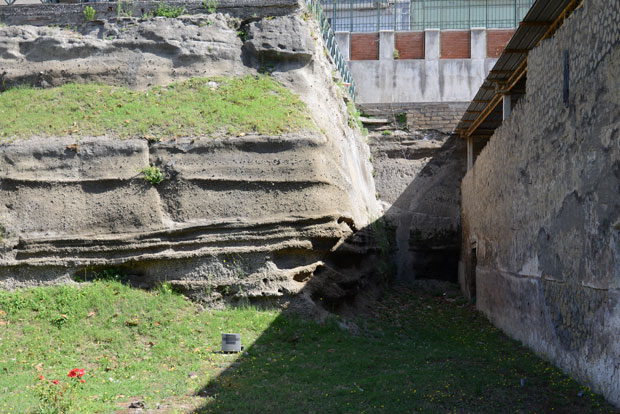
The hard, thinner layers seen here at the excavation site of Oplontis are evidence of pyroclastic events.
There were six pyroclastic events during the eruption of Mount Vesuvius in 79CE. There was no lava. Lava flows when the rising magma is so hot and so fluid that the expanding gases within it easily escape. The rising magma released in the 79CE eruption was molten, but not hot enough to release its gases, which rapidly expanded with the decrease in pressure, causing a sudden, titanic explosion, expelling what would otherwise be lava straight up in gasified form.
This volcanic cloud leveled off at various heights up to twenty-one miles during the eruption while spreading southward, raining volcanic ash at rates up to several inches per hour on the land below. The explosive power that supported this bellowing cloud lasted for close to twelve hours before weakening enough to begin a series drops, or surges ~ the pyroclastic events. Each drop sent this cloud of superheated volcanic material rushing down the slopes, burying towns and wiping out all life along the way.
Herculaneum and Oplontis were among the first towns to be destroyed at approximately midnight, while Pompeii was struck around five hours later, most likely by the fourth surge. The sixth and most powerful surge was the one Pliny the Younger wrote about, describing it as being a black, billowing, lightning packed cloud rolling across the bay all the way to his home at Misenum. The ground shook as it turned day to night, raining ash across the land. Although, he and all those around him believed the world was coming to an end, they did luck out. Surges cool as they travel, and while surges separate into lighter and denser material as they travel, the lighter arrived as an ash storm and the denser material never made it.
Science: Time travel. Time travel into the future is possible and proven so, but time travel into the past is not and may well be impossible. However, I wanted my method to be at least plausible. Therefore, I chose to employ a traversable wormhole which general relativity actually allows for. The one caveat being that any time devise traveling into the past can only go as far back in time as the moment of its creation or activation. On the surface, that meant no visits to the ancient past, but being as this is science fiction, I had options.
